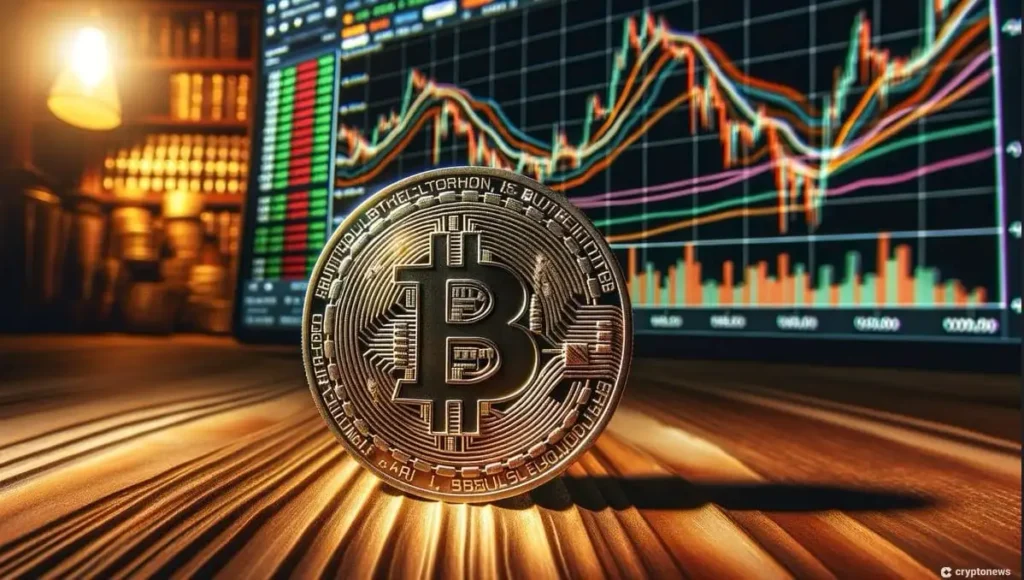Introduction:
The pioneer of digital currencies, Bitcoin, has risen beyond $50,000, and the cryptocurrency community has been a hive of activity. This incredible accomplishment follows the introduction of a spot exchange-traded fund (ETF), which sparked a new surge of interest in the top cryptocurrency. In this piece, we examine the causes behind the sharp increase in the price of Bitcoin, consider the implications of the debut of the spot ETF, and forecast the future of the virtual currency.
For the first time since 2021, the price of bitcoin exceeded $50,000 on Monday, highlighting the dramatic shift in interest in the currency since the debut of mainstream bitcoin investment funds earlier this year.
Since the beginning of the year, the leading cryptocurrency in the market has increased by nearly 15%. This increase has been primarily attributed to the US Securities and Exchange Commission’s decision to reverse a ten-year policy and approve multiple exchange-traded funds (ETFs) that provide investors with regulated products that allow them to track the price of bitcoin.
BlackRock, the biggest asset manager in the world, is among the several well-known Wall Street firms that have provided spot bitcoin exchange-traded funds (ETFs).Still, the price of bitcoin dropped by around 15% in the days that followed the SEC’s clearance, despite high expectations for its debut.
As a result of proof that the ETFs are bringing fresh capital into the market, the token’s recent spike above $50,000, or more than double its previous level, is seen by analysts as a sign that bitcoin is about to make a long-term turn around.
As per James Butterfill, head of research at cryptocurrency investment organization CoinShares, “we’re seeing continued inflows into newly issued funds, and I think we’re seeing much more organic demand for bitcoin as a result, following a disappointing launch of several bitcoin ETFs.”
The long-term investment argument for bitcoin ETFs is attracting asset managers’ attention after the initial waves of inflows into new spot ETFs and outflows from Grayscale Investments’ converted product.
Even though more than $6 billion has been removed from Grayscale’s product since its first day of trading as an ETF, data released by CoinShares indicates that the recently authorized bitcoin ETFs have brought in about $3 billion in net flows.
Issuers anticipate that mainstream investors will ultimately commit a modest portion of their portfolios to products like bitcoin ETFs in addition to traditional exposure to equities and bonds, as crypto services continue to permeate the realm of traditional finance.
The managing director of Brown Brothers Harriman’s US ETF services division, Tim Huver, predicted that as time goes on and the investment becomes more seasoned, there would be a noticeable allocation made to it. The adoption and interest in that space should rise, in my opinion.

Senior alternatives ETF strategist Kathy Kriskey of Invesco, which teamed with Galaxy Digital to create a bitcoin ETF last month, continued, “We’ve been saying to clients that among the most significant considerations is comprehending the value of getting off zero.” According to her, investors might begin by reallocating 1% of their stock exposure to bitcoin. She stated, “I think in discussions with specialists right now, the prospect of going between 0 to 1 per cent is palatable.”
The optimism that the cryptocurrency market has weathered some of the worst regulatory penalties and controversies has also helped the business. The biggest exchange in the world, Binance, was fined $4.3 billion by US authorities in November after being accused of violating international sanctions and money laundering.
Expectations that central banks would cut interest rates this year, making riskier assets more appealing to investors, have contributed to the additional spike in optimism around bitcoin. The market anticipates that the anticipated update in April, which would halt the flow of accessible bitcoins on the network, will help the leading cryptocurrency see more increases.
That being said, other experts are less optimistic about bitcoin’s ability to maintain its current upward trend.
The Psaros Center for Financial Markets and Policy at Georgetown McDonough’s faculty associate, Jim Angel, stated, “I’m sure the bitcoin [bulls] will say the world is waking up to the reality of bitcoin, but given how nebulous the bitcoin ecosystem is, it’s hard to tell who’s buying and why.” According to him, the quantity of ardent supporters who wish to purchase bitcoin and the quantity of detractors who wish to sell it will always cause the price to swing sharply.
“When it comes to bitcoin’s value, virtually everything that is discussed online is about short-term technical analysis, and very little is said about its fundamental value,” Angel stated.
The Ascent of Bitcoin:
From its beginnings to its current position as a widely used financial asset, Bitcoin has had an incredible journey. In an attempt to upend the established financial system, Bitcoin was first presented to the public as a decentralized digital money in the wake of the 2008 financial crisis. It has drawn investors from all around the world as it has developed into a store of wealth and an inflation hedge over time.
The price of cryptocurrencies has increased at an unparalleled rate, with both exhilarating highs and heartbreaking lows experienced along the way. Bitcoin has attracted interest and investment despite its volatility, as institutional players are beginning to see its potential as a real asset class.
Impact of Spot ETF Launches:
The introduction of spot ETFs has been one of the biggest movements in the bitcoin space in recent years. Investment vehicles such as this provide investors access to Bitcoin without requiring them to hold the real asset. It is simpler for traditional investors to include digital assets in their portfolios since they watch the price of Bitcoin on many cryptocurrency exchanges instead.
With spot ETFs, institutional and retail investors now have a regulated and easily accessible way to invest in Bitcoin, which has completely changed the landscape of the cryptocurrency industry. Because of its increased accessibility, the digital money has been more and more in demand, pushing up its price.
Institutional Investors’ Role:
The price of Bitcoin has recently increased, and institutional investors have been a major factor in that increase. Institutional investors are turning to Bitcoin as a store of value and a hedge against economic instability due to the low returns in traditional asset classes and rising fears about inflation.
The introduction of spot ETFs has given institutional investors more confidence in Bitcoin by giving them a recognizable and regulated means of investing in the virtual asset. This infusion of institutional money has given the market new life and helped to push the price of Bitcoin beyond $50,000.
Regulatory Advancements and the Attitude of the Market:
In many nations, Bitcoin remains a gray market in terms of regulations, even with its increasing recognition. The market for cryptocurrencies has historically been very volatile due to regulatory uncertainty, with crackdowns by regulators frequently resulting in abrupt price changes.
On the other hand, recent events indicate that regulatory obstacles could be lessening, at least in certain areas. A rising acceptance of digital assets in the traditional banking environment is shown by regulatory bodies’ approval of spot ETFs, which may lead to further clarity regarding regulations and adoption.
Furthermore, the introduction of spot ETFs has improved investor confidence and market sentiment, fostering hope for Bitcoin’s future. The cryptocurrency industry as a whole is expected to continue growing and maturing as more investors and institutions come to appreciate digital assets.
Obstacles and Prospects to Come:
Although investors should be happy with the recent spike in Bitcoin’s price, there are still obstacles to overcome. The market for cryptocurrencies is still characterized by volatility, and regulatory uncertainty is a major concern.
In addition, there are an increasing number of rival cryptocurrencies that compete with Bitcoin for investor interest and market dominance. Another factor that might jeopardize Bitcoin’s decentralized nature is the rise of central bank digital currencies (CBDCs).
These difficulties do, however, present chances for more innovation and expansion. The introduction of spot ETFs is only the most recent development in the mainstream acceptance of Bitcoin, and there remains a great deal of room for growth and integration into the world financial system.

In summary:
The price of Bitcoin skyrocketed beyond $50,000 when spot ETFs were introduced, demonstrating the increasing acceptability of digital assets by the general public. Demand for Bitcoin is rising as a result of institutional investors’ growing recognition of the cryptocurrency as a reliable store of wealth and a hedge against economic unpredictability.
Although there are still obstacles to overcome, such as ambiguous regulations and competition from other cryptocurrencies, the introduction of spot ETFs marks a critical turning point in the development of Bitcoin. With the ongoing maturation of the cryptocurrency sector, Bitcoin is expected to assume a more significant position in the global financial scene.
For Bitcoin and the larger cryptocurrency ecosystem, the future appears bright as both investors and institutions embrace digital assets. Bitcoin is only now starting its road towards widespread acceptance thanks to clear regulations and increasing use.




